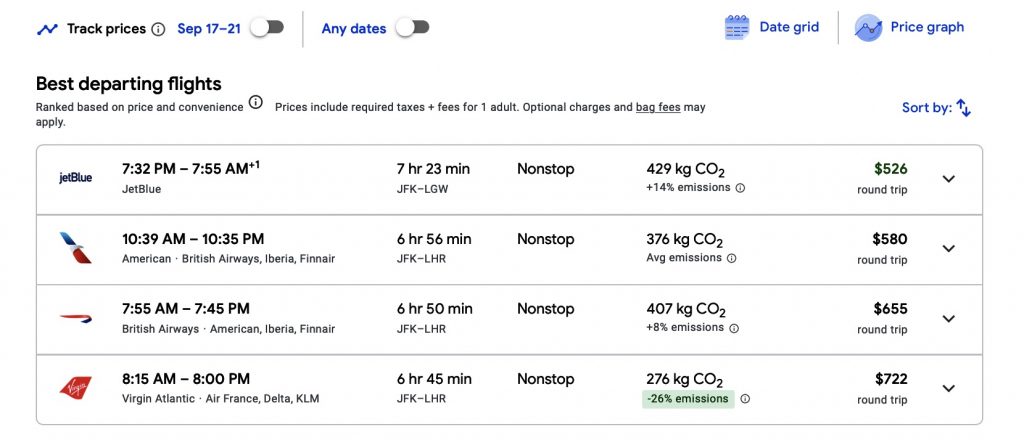Skift Take
Google didn't bow to airline pressure on this one, nor is it trying to greenwash. Instead, Google is trying to get the data right on the non-CO2 climate impact of flights.
If you are searching Google Flights to decide on a New York to London roundtrip in mid-September, and you want to book the flight with the lowest nasty impact to climate change, you might opt for a Virgin Atlantic, Air France-Delta-KLM trip because its CO2 emissions are estimated to be 26 percent lower than what’s typical for the route while the JetBlue flights might exceed the routine climate wallop by 14 percent.
However, your choice could potentially be wrong from a climate change perspective because earlier this summer Google stopped including the impact of contrails — those ice cloud trails behind the aircraft that trap heat but look pretty as jets disappear from view across the skies. Scientists say that the adverse environmental impact and global warming affects of contrails may be just as great, if not greater, than CO2 emissions.
Google eliminated contrail data from its emissions calculations after engaging with academics who counseled that the science of measuring the contrail impact from specific flights isn’t precise. And the adverse impact impact of contrails can vary widely depending on whether it’s a daytime or nighttime flight, and other factors.
Google previously had been multiplying the CO2 emissions by a single number for all flights to take non-CO2 emissions into account.
That could skew the real-world analysis of one specific flight versus another so Google chose to just use CO2 impacts in its calculations on Google Flights as a stopgap measure. It intends to add contrail data to the mix when it is comfortable that the data is accurate.

“We strongly believe that non-CO2 effects should be included in the model, but not at the expense of accuracy for individual flight estimates,” a Google spokesperson said. “To address this issue, we’re working closely with leading academics on soon-to-be-published research to better understand how the impact of contrails varies based on critical factors like time of day and region, which will in turn help us more accurately reflect that information to consumers.”
But Google’s elimination of contrail data — Skyscanner likewise doesn’t include it — has led to controversy.
The BBC ran a story recently with the headline, Google ‘airbrushes out’ emissions from flying, BBC reveals. The story inferred that Google bowed to pressure from airline partners to make them appear more environmentally friendly.
The BBC story quoted a Greenpeace scientist as saying: “Google has airbrushed a huge chunk of the aviation industry’s climate impacts from its pages.”
John Fleming, senior scientist at the Climate Law Institute, Center for Biological Diversity, said Google is underestimating aviation’s impact on the climate because it removed non-CO2 factors.
“Removing the effect of non-CO2 factors completely doesn’t seem like valuing accuracy,” Fleming said. “Further, in their modeling, they keep the labeling ‘CO2e’, which implies consideration of both CO2 and non-CO2 factors, which is misleading since they are no longer doing so. If anything, it would have been better to leave the non-CO2 data and edit as they acquired more stakeholder input or more accurate data, rather than remove it altogether.”
Google seems to be taking some of that type of criticism into account. Google is developing a Travel Impact Model on GitHub to measure and share learnings with interested parties. Google confirmed to Skift that it has dropped the label “CO2e” in the model’s documentation, and now is substituting “emissions” as a more generic label.
However, on Google Flights, travelers see the impact labeled as “303 kg CO2, -19% emissions,” for example, which means that the estimated 303 kilograms of CO2 used for one particular flight is 19 percent lower in emissions than for the typical flight on that route. However, as with the Travel Impact Model, Google Flights no longer includes non-CO2 impacts, such as for contrails.
Google Flights enables travelers, if they choose, to search for flights based on environmental impact, and it will list train options, as well, if there are any on that route.
When asked about Google’s decision to eliminate contrail data — temporarily, according to Google — from its airline emissions calculations, Marc Stettler, who has a Ph.D. in engineering and is a senior lecturer at the Imperial College of London, cited a BBC interview he did on the topic.
In the interview, Stettler concurred with Google that contrail data, while hugely impactful when it comes to global warming, isn’t accurately measured at this juncture for specific flights because there are so many variables, such as atmospheric conditions during the flight.
“We know an average value that was previously included in the calculator is not accurate and there are better ways we can come up with more accurate estimates,” Stettler said. “I am interacting with Google on improving those estimates. I don’t speak on behalf of them, but I do have confidence it will be reinstated at some point.”
Flight search engine Skyscanner, like Google does not include contrail data in its carbon emission calculations.
“Our Greener Choice label highlights flights that contribute a minimum of 6 percent less than the average emissions for a particular route,” a Skyscanner spokesperson said. “This is to allow travelers to easily understan and compare the impact of their preferred flight in order to make an informed choice close to the point of purchase.”
The Daily Newsletter
Our daily coverage of the global travel industry. Written by editors and analysts from across Skift’s brands.
Have a confidential tip for Skift? Get in touch
Tags: airlines, climate change, flights, google, google flights, online travel newsletter, skyscanner, sustainability
Photo credit: Google has temporarily eliminated the environmental impact of contrails from Google Flights. Pictured is the contrail from an aircraft as seen in March 20, 2018. Source: Flickr.com K. Bahr https://www.flickr.com/photos/158350039@N03/27245381168/in/photolist-HvzGBb-2kj6T3d-2kuY9Mj-dn8rRo-2k28pDt-2kj6JVB-ik4vA-2ktmNqk-9rahis-2kqErJG-2kuUX8W-2jf2EXN-2kS9Mma-JZ5y7N-2kHjFe9-GjoFqE-2k5r4yV-2kS8eE4-imACd-2kLg3s7-2jRJYsr-imACg-jFF8sp-2kSdxCE-djh35B-2jNS1v6-2iRjAdR-2jQaznW-2kuUhXx-2iTZoXA-2kuU88T-Lov9uU-qUYJ1a-2kScdTF-2kuUFBW-5PVcWr-2kKBNPQ-j4XPzo-2jdy7sd-EKY6sw-2k9TRNi-2kLcMMs-2jZwUD4-k6iT2s-2iRmaqr-2kj6JWU-2jgfuYG-J5zXZX-2jgfB5a-EgptM
